Drawing Tools
My favorite pens and pencils that I can recommend:
This list is constantly updated as I discover new tools and change my habits. Also, some of the products that were listed here are sadly no longer available - I will try to update this list for this, too!
Pens
LAMY Safari M and F nibs
I use the cheaper LAMY Safari fountain pens for drawing lines for many of my illustrations and sketches. The M broader nib works well on watercolor papers that are not too rough, and the EF thinnest line nib fits well with smooth paper sketchbooks. These pens are sturdy, can be fixed easily (the nib is quickly replaceable), and can be used with many inks with a converter. All the illustrations for my “Tokyo at Night” book were done with a LAMY Safari pen.

IndiGraph fountain pen, EF nib
I have been using this fountain pen since I got the prototype from its creator just for some testing. It stayed in my pen case, and I'm still using the final version with the extra fine EF nib. This fountain pen (thanks to a specially designed cap) can be safely used with black, waterproof India Ink, which makes it perfect for sketching and using together with watercolors. The pen is almost entirely made of metal, and the nibs are very easy to replace. I have been making all my recent storefronts illustrations with this fountain pen.

Pilot ELABO (or Falcon outside of Japan), metal body, SF nib.
I have been interested in this pen for some time as I have seen excellent art done with it by many artists. I finally bought the metal body, SF nib version, and it has never left my pen case so far. I can not explain it very clearly, but there is a special something about how the more flexible nib allows for very thin and controlled lines and more dynamic strokes too. A very unique pen, but not for everyone, I expect. I drew the lines for, for example, this piece with this fountain pen.
Tip: there are plastic and metal versions - they feel a bit different in hand due to weight difference.
ROTRING ISOGRAPH
I usually use my fountain pens for line work, but if I want thinner, more stable lines, I use an isograph. I used to use a Faber-Castell rapidograph, but as they are not easily available in Japan, I'm currently using the Rotring Isograph pens of various line widths. I usually take good care of cleaning the pens if I don't plan to use them for longer, so I haven't had any problems with clogging. I'm using the original Rotring black ink. One tip: The line thickness and flow can vary depending on how well the paper handles the Rotring ink.

Pentel GFKP3-A Brush Pen
I like to use Japanese brush pens. Unfortunately, most of them have non-waterproof inks or marker-like nibs. This one combines a good brush nib with waterproof black ink. The nib provides good flexibility and control balance with a really fine line finish if needed. Also small in size (Japanese brush pens can be very long and thick-bodied), light, and refillable! The ink flow is a bit fast and can produce thick, hard-to-control lines on some types of paper.

Kuretake Sumi brush pen
Even though this brush pen is a bit more expensive than your standard disposable ones, I like that it feels more high-quality in hand and makes you want to paint with it. It has a great Kuretake brush with an exceptionally sharp pointed tip which, combined with a perfectly balanced ink flow, allows for beautiful lines and even some dry-brush effects. This pen comes with three spare cartridges, and you can also buy ones with more waterproof ink (more, but not completely waterproof, sadly). I used these pens for my "Hokkaido in Ink" illustrations.

Inks
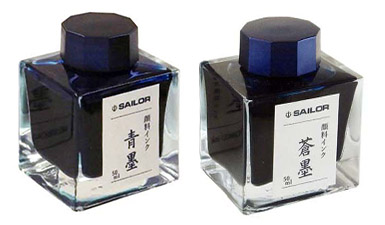
SAILOR Sei-boku and Sou-boku inks
A pair of great blue-black inks that can be used in fountain pens. They differ in color - the Souboku ink is more black, but both variations give deep, vibrant color lines. Both inks are pigment based, and what 's more important - waterproof, which allows me to paint over the lines with watercolors. I used these inks extensively in my "Tokyo at Night" book.
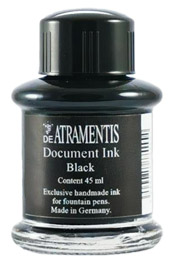
De Atramentis Document ink Black and Grey
Good, very waterproof fountain pen inks. I use them both in regular fountain pens, not meant for India Ink. I especially like how the grey ink allows me to get a bit of a depth effect, with lines not being perfectly black.
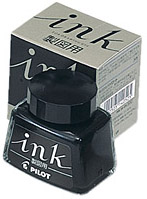
PILOT SEIZUYO (drafting ink)
This is the standard ink used with dip pens by most Japanese comic artists. As I'm not very comfortable with drawing only using nib pens, I mostly use this ink with brushes for covering larger areas black or for adding textures and dry-brush effects to my illustrations (like HERE). This ink also smells nice (?).
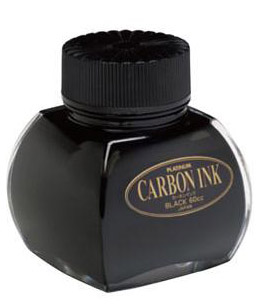
Platinum - Carbon ink
I use this black ink a lot in my works when waterproof black ink is needed. This ink gives beautiful black lines and washes and is very waterproof. I use it in fountain pens while being very careful to clean them afterward and not let them dry out!

ROTRING black ink
For the isograph pens, I use the original Rotring black ink. This ink is beautifully black and fully waterproof. It also dries really fast on paper, so I did not have problems smudging it with my hand by accident. One tip: the white ink of the same brand comes in a similar package, and I once bought it by mistake!
Pencils
Palomino Blackwing pencils (all four types)
Well, I'm one of these people who like to use pencils that have erasers on top. It's a shame that Mitsubishi Hi-Unis don't come with one. Instead, I like to use the Palomino pencils, especially the harder lead versions (I don't use the softest core ones so much). A Japanese company makes the cores, so the drawing quality is as good as the finish of the pencil itself, but the pencils feel more "textured" or "grainy" on paper than, for example, the Mitsubishi Hi-Uni. Also, the eraser is extendable and replaceable!

Mitsu-Bishi Hi-Uni from grade F to 5B
I tried a lot of Japanese brand pencils and like all of them, but for me, the Hi-Unis are the best (closely followed by TOMBOW). These pencils feel extremely soft and "silky" and give consistent, dark lines. Also, the quality of the wood and finishing is superb! Because of these characteristics, these pencils are widely used in Japanese animation for drawing animation frames. Tip: Japanese pencils generally feel a lot softer than European pencils of the same hardness.

2mm Lead Holders
I used lead holders - or clutch pencils - from when I was a kid, and I still am very fond of them. You can mix and match your favorite brand of holder and lead, it's very fast and easy to sharpen them (using a knife or a dedicated sharpener), and once the lead is retracted back into the barrel, they are ideal for taking for a sketching session outside. I have and use many brands, but so far, the simple Koh-i-Noor Versatle, Caran d'Ache Fixpencil, and Steadtler mars technico work great. As for the leads, I usually go for Steadler line or Mitsubishi Uni if I need something softer and smoother.
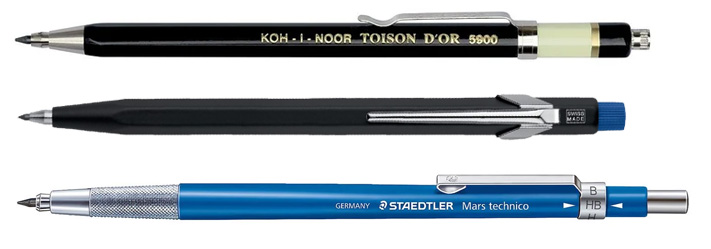
PRISMACOLOR COL-ERASE Red
I use these erasable colored pencils for sketching when I plan to ink the picture without erasing the pencil lines. I can later erase the sketch in Photoshop because it's red, a different color than the lines. This pencil makes easily erasable marks even though it's red, which is very useful!

BIC EVOLUTION HB
I remember using these pencils when they were still made by Conté. They are proof that sometimes the most usual and cheap supplies can be really useful. These pencils have cores with a somewhat plasticky feel, and the line they produce is not very black or visible. Normally these are flaws, but for me, these pencils are ideal when making underdrawings for paintings. They leave marks easy to erase and cover with paint without that scratchy feeling that hard-grade pencils have.

PENTEL GRAPH 1000 FOR PRO 0.4, 0.5, 0.7 and 0.9mm
A very sturdy and well-designed series of mechanical pencils (I have had the 0.4 one for a few years already). The "working end" is made of metal, but the "holding part" is made of high-quality plastic, so the whole thing is balanced well and not too heavy. The grip part has a perfect combination of rubber anti-slip parts with ergonomic thickness. The pencil also has a label to remind you what leads are inside. It comes in 0.3, 0.4, 0.5, 0.7, and 0.9 varieties, and I own and can recommend all of them! I use these pencils with 2B leads for everyday sketching.

Erasers

Tombow MONO
I use the popular in Japan Tombow MONO Erasers most of the time.
SAKURA CRAYPAS RBE400 electric eraser
While sketching and drawing final lines alike, I use an electric eraser - a tool widely used by animators. The RBE400 is battery-powered but has a very strong motor. It erases perfectly, quickly, and very cleanly, even the smallest details. This eraser is a little bit more expensive than those of other brands, but I think it's worth the price - I really got used to it and ended up using it all the time!

